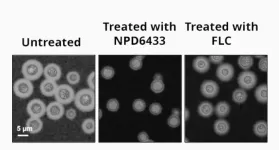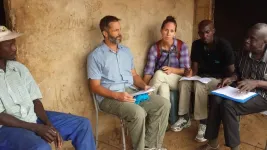(Press-News.org) COLUMBUS, Ohio – More than 4 out of 5 older women survivors of colorectal cancer may be experiencing a range of gastrointestinal symptoms many years after being diagnosed and treated, a new study suggests.
Using data from the Women’s Health Initiative, researchers found that 81% of colorectal cancer survivors reported persistent GI symptoms, with abdominal bloating and gas topping the list as the most common and severe problem. The average time since diagnosis was eight years for all participants whose data was used in the study.
The analysis also showed that severe GI symptoms were linked to poor quality of life, interference with daily social and physical activities, and low body image satisfaction.
“Many cancer treatments show great success, and many cancer survivors are living longer than ever before,” said lead study author Claire Han, assistant professor of nursing at The Ohio State University. “GI symptoms among survivors have been under-investigated in the past, but we found that they are very prevalent even up to 25 years after diagnosis, suggesting it’s very important to consider GI symptom management as part of their survivorship care.”
The study was published recently in the journal PLOS One.
While depression, anxiety and fatigue are commonly monitored following cancer diagnosis and treatment, Han said that when she was working as a nurse practitioner, she heard from many colorectal cancer survivors that they were experiencing GI symptoms and having a hard time finding relief.
This secondary analysis cannot identify the reasons for the symptoms, but the location of cancer in the colon and rectum and treatment-related effects on the gut and the microbes living there could be a factor, said Han, also an investigator in the Cancer Control Program at The Ohio State University Comprehensive Cancer Center.
The study did show that GI symptoms were accompanied by the psychological distress experienced by many cancer survivors – but whether gut problems were causes or consequences of quality-of-life issues, particularly fatigue, sleep problems, depression and anxiety, could not be determined.
“Cancer survivors with high psychological symptoms may have a higher stress level that could inflame the gut and lead to GI symptoms,” Han said. “The causal direction could be bidirectional – which comes first doesn’t really matter because both types of symptoms are present.”
Data on 413 colorectal cancer survivors for this research came from the Women’s Health Initiative’s Life and Longevity After Cancer (LILAC) Study involving postmenopausal women who had been diagnosed with certain types of cancer. Their average age was 71 years, with an average age at the time of diagnosis of almost 63. Among the sample, 63.2% had undergone surgery for their cancer, and 34.4% had received multiple treatments, including surgery and chemoradiation.
The secondary analysis included data from questionnaires assessing a variety of measures, including demographics, GI symptoms, non-GI symptoms, dietary habits and physical activity, as well as how these measures affected quality of life.
Han said this is the first study in cancer survivors to document the impact of individual GI symptoms versus considering gut issues all together in a cluster.
Abdominal bloating and gas was reported by 54.2% of participants (17.2% patients reported moderate to severe symptoms), followed by constipation (44.1% overall, 12.6% moderate to severe), diarrhea (33.4% overall, 10.4% moderate to severe) and abdominal/pelvic pain (28.6% overall, 6.8% moderate to severe). When all symptoms were combined into a composite score, 15.4% of survivors reported moderate to severe overall GI symptoms.
Being within five years of diagnosis and surviving a stage III cancer were associated with a higher likelihood of reporting persistent GI symptoms. And the severity of depression, anxiety, fatigue and sleep problems was higher in the GI symptom group than in women without GI symptoms.
These and other findings suggest the need for comprehensive interventions for colorectal cancer survivors, Han said, such as psychosocial support, pain management, individualized nutritional counseling and physical rehabilitation.
Han is an investigator in the Center for Healthy Aging, Self-Management and Complex Care in Ohio State’s College of Nursing. Co-authors Electra Paskett and Matthew Kalady of Ohio State also worked on the study with co-authors Kerryn Reding, Rachel Yung and Heather Greenlee of the University of Washington and Fred Hutchinson Cancer Center.
The WHI is funded by the National Heart, Lung, and Blood Institute.
#
Contact: Claire Han, Han.1985@osu.edu
Written by Emily Caldwell, Caldwell.151@osu.edu; 614-292-8152
END
Just a handful of years ago, retinoblastoma had the medical field stumped. This pediatric eye cancer cannot be directly biopsied, which means clinicians must diagnose the disease by visual examination and imaging. Recently, a researcher at Children’s Hospital Los Angeles developed a new way to diagnose retinoblastoma by sampling the fluid at the front of the eye. These liquid biopsies also offer genetic and chromosomal information, which gives a more complete picture of each child’s disease. Now CHLA will lead an international liquid biopsy retinoblastoma study, the first of its kind.
A New Line of Research
Jesse Berry, MD, is the Director of Ocular Oncology ...
Climate change goals set out in the Paris Agreement are only economically reasonable if non-market factors such as human health and loss of biodiversity are prioritised, according to a new study published by Dr Taikan Oki, former Senior Vice-Rector of United Nations University headquartered in Japan, in IOP Publishing’s academic journal Environmental Research Letters.
A multi-disciplinary, collaborative effort from researchers at 23 institutions including The University of Tokyo, National Institute for Environmental Studies, and Kyoto University, the new study provides a cost-benefit analysis ...
Only 19% of Saudi Arabian women are diagnosed at stage I of cervical cancer where survival rates are highest, according to a study published by the King Abdulaziz University. To further motivate action to combat cervical cancer, BGI Genomics today released its State of Cervical Cancer Awareness Report in Saudi Arabia. This report assesses the level of knowledge, attitudes, and practices related to cervical cancer screening and HPV vaccination. By examining these key areas, this survey seeks to highlight the associated barriers and opportunities. 1,878 female respondents from six countries ...
Smoking in pregnancy can harm developing babies, especially their growth . Current guidelines recommend that pregnant smokers who find quitting difficult should be provided with nicotine replacements products and stop-smoking services usually recommend nicotine patches.
This research published in NIHR Journals Library, suggests that pregnant women should also consider e-cigarettes.
The study included 1,140 pregnant women who were trying to stop smoking who were divided into two groups. Half of the women received e-cigarettes; the other half received nicotine patches. Both approaches were equally safe. The only meaningful difference was that fewer ...
A group of international researchers has achieved a breakthrough in computer security with the development of a new and highly efficient cipher for cache randomization. The innovative cipher, designed by Assistant Professor Rei Ueno from the Research Institute of Electrical Communication at Tohoku University, addresses the threat of cache side-channel attacks, offering enhanced security and exceptional performance.
Cache side-channel attacks pose a significant threat to modern computer systems, as they can stealthily extract sensitive information, including secret keys and passwords, from unsuspecting victims. ...
WASHINGTON — People with type-II diabetes who drank the fermented tea drink kombucha for four weeks had lower fasting blood glucose levels compared to when they consumed a similar-tasting placebo beverage, according to results from a clinical trial conducted by researchers at Georgetown University's School of Health, the University of Nebraska-Lincoln and MedStar Health. This finding, from a pilot 12-person feasibility trial, points to the potential for a dietary intervention that could help lower blood sugar levels in people ...
Researchers at the RIKEN Center for Sustainable Research Science (CSRS) and the University of Toronto have discovered a new way to attack fungal infections. The key is to block fungi from being able to make fatty acids, the major component of fats. Resistance to anti-fungal drugs is increasing and this new approach will be particularly useful because it works in a new way and affects a broad range of fungal species. The study was published in the scientific journal Cell Chemical Biology.
Most of us are familiar with athlete’s ...
Only 28.5% of Thai women are diagnosed at stage I of cervical cancer when survival rates are highest, according to a study published by the Mahidol University. To further motivate action to combat cervical cancer, BGI Genomics released its State of Cervical Cancer Awareness Report in Thailand. This report assesses the level of knowledge, attitudes, and practices related to cervical cancer screening and HPV vaccination to highlight the associated barriers and opportunities. 1,878 female respondents from six countries and ...
Researchers have revealed the unique ‘cheating’ strategy a New Zealand insect has developed to avoid being eaten – mimicking a highly toxic species.
In nature, poisonous species typically advertise their toxicity, often by producing high contrast colours such as black, white and yellow, like wasps and bees.
Along similar lines, New Zealand’s cyanide-producing stonefly, Austroperla cyrene, produces strong ‘warning’ colours of black, white and yellow, to highlight its threat to potential predators.
In a new study published in Molecular Ecology, University of Otago Department of Zoology researchers reveal that an ...
It’s an elegant solution: Remove the habitat of a parasite-carrying aquatic snail and reduce the level of infection in the local community; all while generating more feed and compost for local farmers.
A collaboration of scientists from the United States and Senegal focused on doing just that by removing overgrown aquatic vegetation from areas upstream of the Diama Dam in northeastern Senegal. In doing so, they generated positive impacts to the local communities’ health and economies.
“It is rare and gratifying when we can find a potential win-win solution to both human health ...







